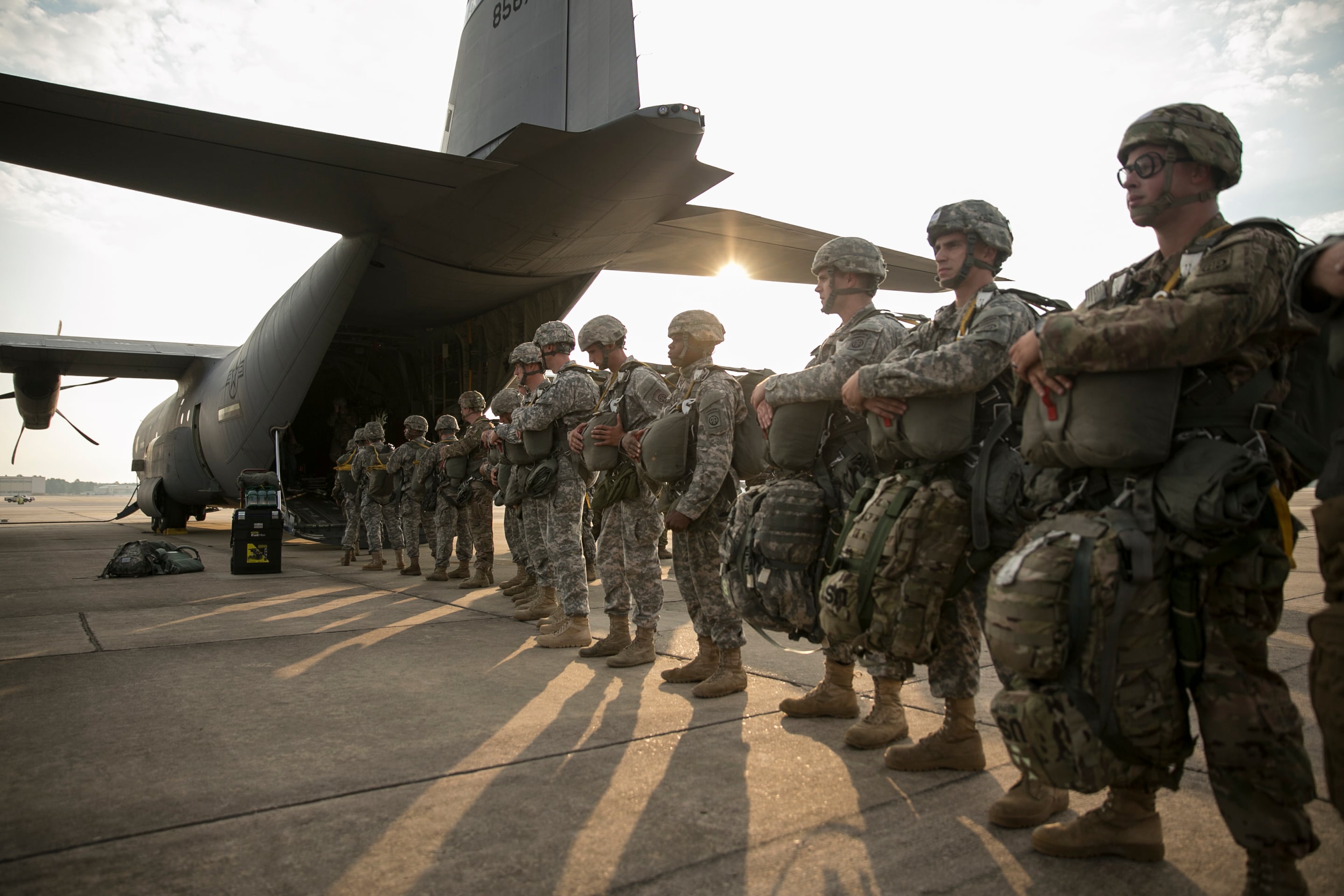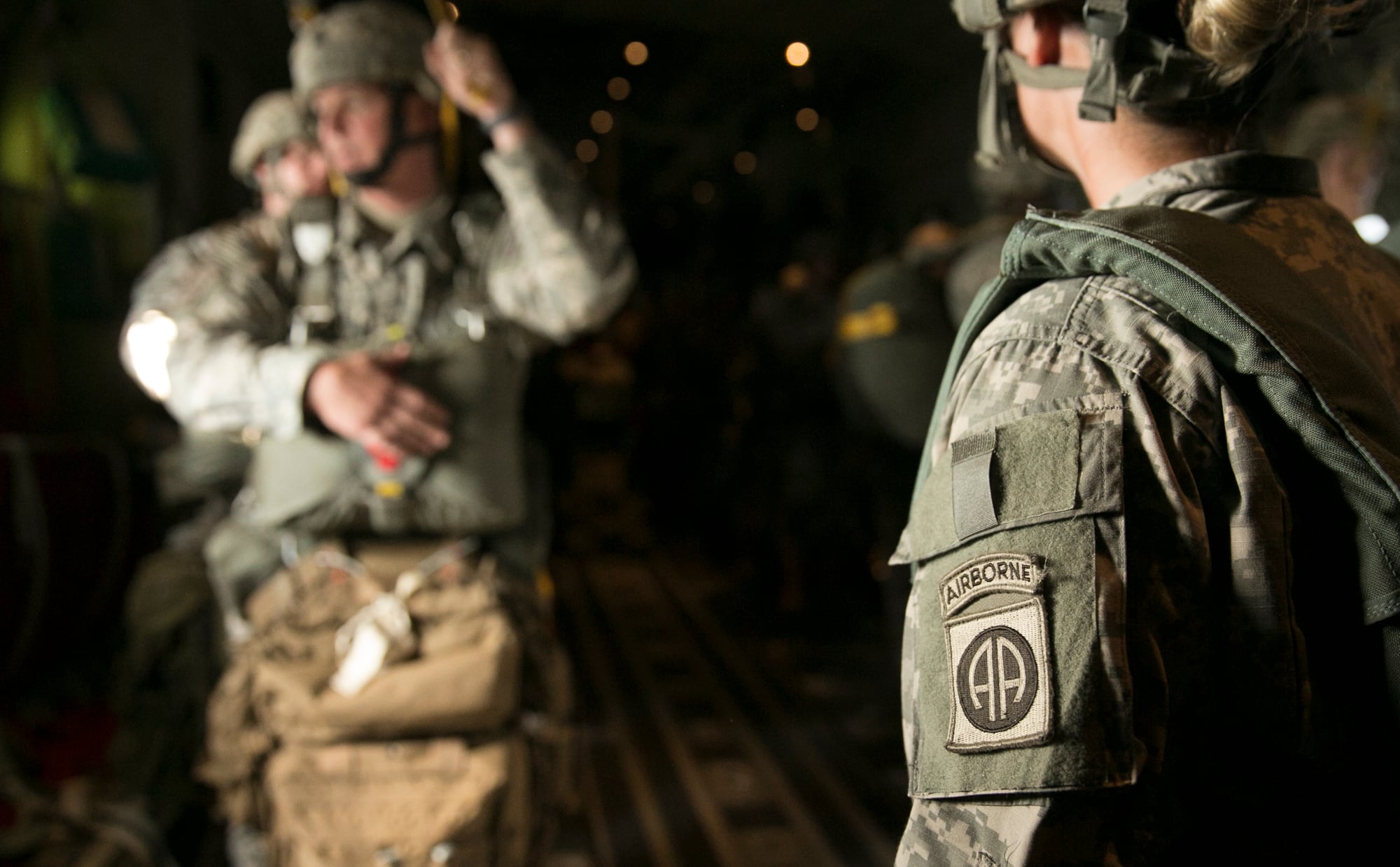ZARAGOZA, Spain — About 1,200 soldiers from 13 countries looked up toward the thin white clouds stretching across the sky. Having just participated in a brief NATO battle demo, they awaited the November event's finale.
First Lt. Tim Pena would later say it was "a beautiful day to jump." But he hadn't quite arrived just yet.
Right on time, three C-17s cleared the hills to the north, about 1,000 feet above the ground. They flew over the fictional village of "Casas Altas" — an assembly of concrete buildings where the brief staged battle had occurred. A few seconds later, soldiers who nine hours earlier had taken off from Fort Bragg, North Carolina, began to pour from each of the two rearward doors, in standard one-second intervals. Over 500 U.S. paratroopers from 2nd Brigade, 82nd Airborne Division floated to the rocky ground below — it was a beautiful sight.
The jump capped an event, designed largely for the international press, to wrap up NATO's broader, 36,000-troop, 30-plus-country exercise known as Trident Juncture. NATO described the demonstration as a message to Russia, though Russia declined an invite.
Nevertheless, NATO and U.S. leaders were pleased. The airborne jump may have been the most visually stunning and logistically impressive element of Trident Juncture: hundreds of soldiers in the U.S. travel across the ocean and reach foreign land — on time, without an airstrip, and armed with M4s.
"It’s a great opportunity for us to show what we can do on the Global Response Force," said Col. Joseph Ryan, the 2nd Brigade commander who jumped along with his soldiers.
The GRF, generally a rotating brigade in the 82nd Airborne Division, is the nation’s quick reaction force designed to rapidly deploy in an emergency. As the Spain exercise demonstrated, Army regards large-scale combat jumps as a crucial capability of the GRF.
But some consider this tactic to be impractical, disconnected from modern war and an unnecessary expense, if not a virtual suicide mission in a real war. Mass combat jumps have been rare since their introduction in World War II, and rarer still in the last 20 years.
"(The) current composition of the United States airborne forces appears more a product of the airborne community’s lobbying efforts in favor of their own size and autonomy than cold calculations about national interests or military requirements," writes military scholar Marc DeVore in his 2015 Army study "When Failure Thrives."
DeVore’s study, the first product of the new Army Press, sent shockwaves through the airborne community. In 90 or so pages, DeVore argues that airborne still exists today not because of successful operations, but rather institutionalization and military culture. Even from the start airborne operations produced inconsistent results, and he said in recent decades technology advances have all but removed them from the modern battlefield, both American conflicts and beyond.
"We’ve gone 38 years with it being tough to say any given airborne operation was necessary to accomplish the overall objective of a given operation," DeVore told Army Times.
DeVore is not alone. Retired Col. Doug Macgregor has emerged as a vocal Army critic since retiring in 2004. The former 1st Squadron, 4th Cavalry commander holds a PhD in international relations and calls large-scale airborne operations an "anachronism, a thing of the past" and compared it with horse cavalry use in World War II.
Top Pentagon leaders don’t buy it. They acknowledge a major airborne combat operation is a low-probability option, but say a siz
e
able airborne assault remains a vital capability and deterrent.
"The whole new Army operating concept is we’re back to our expeditionary concept ... the beauty of airborne forces is they were always designed to be expeditionary," said Lt. Gen. Joe Anderson, the Army's deputy chief of staff for operations and a former XVIII Airborne Corps commander. "Typically, an enemy is not going to want to give you free access to a runway, they’re going to damage it. So how else are you going to get in there and get that stuff capable if you don’t have some light expeditionary package that is able to get in there, doesn’t need a lot of supplies?"
"It’s not an Army requirement … It’s a national security requirement," Lt. Gen. Stephen Townsend, commander of XVIII Airborne Corps, said of robust and rapid forced-entry capacity. "This is the Army’s highest levels saying this capability is something the country needs."
Many of the Army’s top leaders have earned their jump wings: Chief of Staff Gen. Mark Milley, Vice Chief Gen. Daniel Allyn, U.S. Special Operations Command chief Gen. Joseph Votel and acting Army secretary Patrick Murphy. Nine of the Army’s 13 four-star generals have led or served in the 82nd or XVIII Airborne Corps.
Airborne also offers training, morale, retention and recruitment perks, according to leaders. Many airborne soldiers absolutely love what they do, despite — or sometimes because of — its inherent risks.
As many generals have noted, you can’t plan for every war and the U.S. has consistently failed to predict where the next war would be fought, or what specific skills would emerge as indispensable. No one suggests jumping out of planes in general to be obsolete; Special Forces and the 75th Ranger Regiment frequently jump into enemy territory.
But does the Army need four-plus brigades — from combat troops to cooks to public affairs officers — training for low-altitude, low-speed static line jumps with ever-tightening budget restraints? (Anderson said airborne brigades costs about 10 percent more in maintenance than standard light infantry, but still roughly a third as much as an armored unit.) And given a paucity of use that spans wars and decades, what is that tactic’s true place in a modern battlefield?
In mid-August, the Army celebrated 75 years of airborne. It was on Aug. 16, 1940, when the 29th Infantry Regiment conducted its first jump at Fort Benning, Georgia. Since that day, the mission task remains simple: get soldiers and equipment safely from a speeding plane to the ground.
Over the last 15 years, the members of the 82nd have seen more than their fair share of combat in Iraq and Afghanistan — but the vast majority have never sniffed a combat jump. In fact, few large jumps into hostile territory have launched since World War II.
The Army planned to downsize the airborne 4th Brigade Combat Team, 25th Infantry Division in Alaska into a battalion task force by 2017. Milley told Congress in February, however, he wants to push back that move at least a year. If made, that cut would bring five airborne brigades down to 4 and 1/3 (three in the 82nd Airborne Division plus the 173rd Airborne Brigade in Europe).
While leaders defend limiting airborne cuts to its share of Army-wide force reduction, others suggest slashing further.
MacGregor does not see significant tactical need for a mass combat jump of infantry forces. He says even basic air defense renders an airborne attack suicidal.

Sgt. 1st Class Cesar Hembree directs paratroopers during a night jump into Fort Bragg, N.C., to conclude the flight home from a NATO exercise in Spain. Army leaders argue airborne to be the only way to get a substantial force into a conflict quickly when there's no airstrip handy.
Photo Credit: Daniel Woolfolk/Staff
"Airborne requires fixed-wing airlift. These forces cannot ‘get in under the radar’ against a major theater power’s defenses," the unapologetically blunt West Point graduate said. "As seen repeatedly in Eastern Ukraine, anything flying low and slow, especially in the large numbers that are needed to move a militarily-useful conventional ground force, is toast in a real war."
But leaders say the training and resources invested are worth it from a capability and deterrence standpoint, even before accounting for intangibles.
"Today the application of a large-scale airborne assault is low probability, but it’s high consequence if we’re not absolutely prepared to do it and do it right," said Brig. Gen. Brian Winski, deputy commanding general of the 82nd Airborne Division.
At the time of the Spain jump, the 2nd Brigade of the 82nd constituted the Army’s Global Response Force before 1st Brigade rotated into the role in December. Within four days the Army can have "an operationally significant force anywhere in the world," Winski said. Along with soldiers, the Army can drop vehicles, artillery and ammunition (but not armor) into place, allowing an array of capabilities. Since airstrips are finite and defensible, dropping near one, taking it over and possibly rebuilding after any sabotaging efforts are fundamentals of airborne training.
"Only the Army, through airborne assault joint force, can meet that kind of timeline and provide that kind of capability," Winski said.

The Army has four-plus brigades of airborne soldiers, though combat jumps have been few and far-between since World War II.
Photo Credit: Mike Morones/Staff
In addition to that "in case of emergency, break glass" capability, leaders like Winski and Ryan stress the paratrooper "spirit" or "ethos" as an additional asset
.
Ryan said problem-solving, ingenuity, adaptability in pressure situations, and trust inherent to the job draw a certain kind of soldier. He said he addressed that ethos to soldiers before Operation Dragon Spear, a joint entry training exercise involving 2nd Brigade’s paratroopers held near Fort Irwin, California.
"I told everybody up front: You know in the end we’ve got a great plan for this mission, and the only thing I can guarantee you is it’s not going to happen this way. So you’re going to figure it out," Ryan said. "I think we find a significant density of the type of folks who enjoy thriving in that sort of culture, that are attracted to these sorts of organizations."
Capt. Paul Corcoran — rear detachment commander of the 82nd Brigade Support Battalion — also said the job attracted a certain type of individual – who straddle a fine line between brave and crazy.
"In theory, you’re committing suicide every time you jump out of a plane….We’re all here, because we’re not all here," Corcoran said, pointing at his head.
While pondering the recent invention of the hot air balloon, Benjamin Franklin reasoned in a 1784 letter to a friend that "ten thousand men descending from the clouds" could "do an infinite deal of mischief before a force could be brought together to repel them."
Airborne was contemplated during World War I but first institutionalized as a tactic by several countries before World War II. The Germans used it in battle first, but would abandon it early on due to high casualties, particularly during the invasion of Crete in Greece. The Allies used combat jumps in the closing months of the war.
But since World War II, scaled-up combat airborne assaults have been rare. The 187th Airborne Regimental Combat Team executed two airborne operations in Korea in 1950 and 1951. Most soldiers dropped into Vietnam via helicopter, with one major combat jump in Operation Junction City.
Jumps since have become smaller and more isolated events, and usually against low-tier militaries. Rangers jumped in to secure an airport during the controversial invasion of Grenada in 1983. A 1989 invasion of Panama was the 82nd Airborne Division’s first combat jump since World War II; it secured an airport after elements from 75th Ranger Regiment dropped onto the airfield earlier and executed other combat jumps during the conflict.
Rare among today's soldiers in airborne brigades is the gold star or "mustard stain" on parachutist wings signifying a past combat jump. Special operations have delivered soldiers by parachute into Afghanistan and Iraq among other places, though never in the kind of numbers requiring today’s division-wide training. The 173rd Airborne Brigade Combat Team, part of U.S. Army Europe, jumped into Northern Iraq in 2003 — albeit into an area already held by Special Forces and Kurdish allies. DeVore, who spoke to Kurdish forces for unrelated research, said the Iraq jump came in an area where Saddam Hussein's army hadn’t operated for many years.
"The Peshmerga was laughing at it as this great publicity stunt," DeVore said.
But leaders say the mere existence of airborne may give potential adversaries pause. In 1994, the U.S. had prepared an invasion of Haiti after the United Nations, for the first time, authorized force to restore a nation’s democracy after a 1991 military coup. Haitian military leaders agreed to a transition plan – with invading U.S. forces already in the air and on the way.
"Looking at the 1940s type operations where we’re jumping massive amounts of paratroopers, that’s probably not ever going to be the case anymore," said Maj. Craig Arnold, the former head of the Advanced Airborne School at Fort Bragg. But he also said the capability of deploying self-sustaining brigade-sized elements remained important: "We can drop a massive amount of boots on the ground in a very short period of time with very little build-up."
Arnold noted that in 2013, French paratroopers helped re-take Mali after a 10-month Islamic extremist occupation. Meanwhile, Russia’s alleged involvement in Ukraine and its aggressive posturing toward NATO allies has commanders discouraging cutting from their playbook.
"The faster we can get people in — that gives our political leaders some options," U.S. Army Europe commander Lt. Gen Ben Hodges said shortly before paratroopers dropped into Spain. "That’s the most important thing: speed gives political leaders options."
Getting military force into a territory where you’re welcome is easy enough. But crashing as an uninvited guest remains a fundamental military obstacle. The question facing the Pentagon: What’s the best way to achieve that mission?
DeVore’s study has become a flashpoint in the airborne community, according to Army Press deputy director Donald Wright, a retired lieutenant colonel and military scholar.
In his piece, DeVore argues that airborne is too large, based on the sheer unlikelihood of a forced-entry operation larger than a battalion.
Townsend vehemently disagrees. He cited DeVore’s work as well, but more as evidence that airborne commanders are constantly evaluating and adapting, and don’t "sit here and drink our own bathwater and say ‘We’re airborne and we’re awesome.’" He deferred to more recent work by RAND, a nonprofit think tank that offers research and analysis to the armed forces. A 2014 study "Enhanced Army Airborne Forces" called airborne forces "unique in their ability to quickly deploy worldwide," and looked at ways to make airborne more potent by infusing light armored vehicles (such as LAV-IIs and Strykers).
"Each case [of airborne operations since Panama in 1989] demonstrated the value of quickly deployable forces to national decision-makers, but some cases also outlined the limitations of primarily foot-mobile, light infantry–based airborne units," the report said. "The analysis focuses on one potential means to enhance the airborne force: incorporating light armored vehicles into the force to increase speed, mobility, and survivability."
The 82nd has been moving to advance just that capability: it has been evaluating an ultra-lightweight combat vehicle that would let paratroopers drop far from an objective protected by air defenses and drive into battle. The Army purchased 33 vehicles for proof of purchase test.
Retired Gen. Barry McCaffrey, who served with the 82nd Airborne Division and later commanded the 24th Infantry Division and Southern Command before retiring in 2001, sees the benefits of airborne but also understands the opposing view. He told Army Times he doesn’t want to "be lynched by 100 paratroopers who would rise from their graves, much less active duty," but still acknowledged that institutional enthusiasm belied the hard-math argument. The capability, he said, is needed — but he estimated the 75h Ranger Regiment could handle 90 percent of potential parachute entrance requirements. He called the need for a BCT airborne operation "a low probability," but still possible.

American service members earned Spanish jump wings at Exercise Trident Juncture near Zaragoza, Spain. While many countries' militaries have airborne forces, many are small or have shrunk largely due to infrequent operational use.
Photo Credit: Daniel Woolfolk/Staff
"You could make the argument that if you always want us to have a brigade combat team ready to fly in X hours, say 48 hours, you have got to have a division: one brigade training, one standing down, one ready. That’s a pretty good argument. But if you were shaving dimes you wouldn’t buy it," McCaffrey said of having even three airborne BCTs.
Retired Maj. Gen. Robert Scales, a former 101st Airborne Division artillery officer, sees airborne as vital. The former Army War College Commandant with a PhD in history from Duke University said criticism of airborne stems from pushback in a "perennial, inside-the-beltway debate," in which defenders of amphibious forced-entry (i.e. Marines) attack airborne. He said between beach landings and airborne, airborne is more cost-effective and useful — both by a huge degree of magnitude. In today’s landscape, airborne remains the only viable option to quickly move an increasingly U.S.-based force into battle, especially since there won’t always be a useful airstrip where force is desired.
"Because of the political power of the Marine Corps, the most expensive and least used military capability in the military is amphibious capability," Scales said, adding that Marines still remain a highly useful land-fighting force. "The whole political thing is ridiculous."

Paratroopers from the 82nd Airborne Division make a practice jump at Fort Bragg, N.C. To remain current on jump status (which comes with a $150 bonus) soldiers must jump at least once every three months.
Photo Credit: Mike Morones/Staff
Macgregor agrees with Scales on the futility of expensive amphibious assault, an incursion technique that saw its last major use at Inchon during the Korean War. But that doesn’t make mass airborne operations useful in his eyes. His analysis is rooted in his general beliefs regarding the structure of the Army: he sees divisions as relics of 1940s force structures bloated with layers of unnecessary non-combat elements, and said the future of the Army is in decisive, long-range force, surveillance and intelligence, and heavy armor. That is what he says allies need and request most from the U.S., much more so than manpower and light infantry. He described Iraq and Afghanistan not as "wars," but as "colonial expeditions" of questionable utility. ("You don’t fight wars from forward operating bases with Motel 6 accommodations," he said).
They offered few lessons to prepare us for the most dangerous potential conflicts, he said. "Modern battlefields are dominated by accurate, devastating firepower delivered in quantity from the air and from tracked armored platforms on the ground."
It’s just too dangerous to be outside heavy armor near an adversary of any strength — whether in a slow-moving low-flying plane, parachuting outside of one, or on the ground in a non-armored vehicle trying to secure an area.
Back inside the Pentagon, Macgregor’s argument has largely been rejected.
Anderson, who participated in the combat jump in Panama, said airborne remained "a very viable option to help shape and, ultimately, decisively fight a war." He also said the Army needs to be able to accomplish some of the low-intensity conflicts that Macgregor disregards, from Grenada to Iraq, where the Army doesn’t face stout air defenses. You need a force big enough to secure an area, Anderson said, possibly before there’s an operable runway (or secured sea or land transport access) for bringing in heavier items.
Hodges, in Europe, agreed. The speed with which a large force can be brought to where there is no runway makes it worth it; if Russia attacked or initiated a Ukraine-style hybrid war (mix of kinetic, subversive and cyber war) against a Baltic country like Latvia or Estonia, the U.S. would want to get a force there before Russian actors could get a foothold. A brigade jumping in would augment local and NATO forces (including U.S. light armored vehicles) already on the ground.
"Everybody in the world knows, when they see this [demonstration], they know what can come behind this. We always want to deter," Hodges said from the ground in Zaragoza.
Citing nuclear capabilities, Townsend rejected the idea that the Army should give up on something just because of infrequent use. He said in some cases the risk of airborne could be worth the reward; he cited Normandy in World War II and, in projecting future scenarios, events such as a loose weapon of mass destruction being moved by a non-state actor.
Scales said the biggest threats to the U.S. — terrorists, possibly in a failed state, with access to a WMD; Russia; or a rogue Iran — have limited sea access and could very plausibly call for airborne operations. And while acknowledging air defenses, he argues they’d be a threat to any force entering hostile territory … and certainly no more devastating than threats to amphibious vessels moving across the water at much slower speeds. Ultimately, tactics and resource allocation also depend on the unforeseen and outside Pentagon control: what political objectives will be sought, how policy makers view the role of the military, and the unforeseen military needs those objectives as well as often-unforeseen threats present.
"If you believe future of ground forces is advise-and-assist, counterinsurgency, that’s different. But everyone inside the beltway is clamoring for a return to [preparation for] large scale wars," Scales said.
Sgt. Stephen Sandoval, after jumping into Spain, said he followed his father’s footsteps into airborne.
"It’s everything I hoped it to be," Sandoval said.
Soldiers rig up with a 53-pound parachute and harness system, generally with another 40-60 pounds of ruck sack dangling between their legs. After hours of training and prep and waiting, they waddle hundreds of yards out to a plane, and wait even longer during the flight.
And most will tell you that jump lasting for about a minute is worth every bit of it. Many obsess over it.
Asked what he liked most about it, Sandoval said: "The thrill. Anything ‘jump.’ That moment when you get out of the plane, when the canopy opens; it’s just great. I wouldn’t trade it for anything."
Winski praised the culture that develops, with an "absolute environment of trust" where soldiers may not know the person next in line, but knows the person will do the job right to keep them safe.
"It’s the unique environment of absolute trust and subordinating your safety," Winski said. "And when you do that together a bunch of times it just increases the unit spirit and confidence in ways that few other things do."
"The culture is so profound," McCaffrey said. "The soldiers are so proud to be doing something complicated, dangerous and exciting. It’s hard to ignore that….That’s what comes out of this: young people who want to serve in that kind of unit."
Pena, the lieutenant who jumped into Spain, put the difference between airborne and other troops more bluntly.
"One’s airborne, one’s not," Pena said, though he quickly added, "at the end of the day we’re all soldiers first." But he said the job "does attract a different type of personnel."
That culture exists for a reason: risk.
Since 2010 the Amy has had five training deaths in airborne brigades or airborne school. Injuries happen too, with about three per thousand jumps, and just over one per thousand major injuries, generally requiring some kind of hospital trip.
All the necessary training comes at a financial cost. Staying current (and paid: jumpers get a $150 bonus per month) requires a jump every three months, which consumes resources, personnel and soldier time to prep and execute the jumps. Regarding training jumps, leaders prefer proficiency to currency, and that means a jump every month or more. Winski said that should include at least a quarterly night airfield-seizure exercise for combat units.
The Army expects to spend about $82 million per year from 2016 and 2017 on bonuses alone to keep about 45,000 soldiers current, according to budget documents the Army provided to Congress.
Anderson said maintaining an airborne brigade costs about an additional $2.2 million over the regular light infantry brigade total of about $21 million. That does not include the added personnel costs of hundreds of riggers who spend their work days packing and inspecting parachutes. At the same time, it’s still far cheaper than maintaining a heavy armored brigade, which can cost triple to maintain, he noted.
"Bang for the buck," Anderson said, "The cost is well worth the capability."

Riggers (in red caps) inspect paratroopers as they prepare to conduct a jump over Fort Bragg, N.C. Airborne has existed in the Army for more than 75 years.
Photo Credit: Mike Morones/Staff
But DeVore said operational costs don’t tell the whole story. According to a 1997 Government Accountability Office report, $7 billion could have been saved by buying fewer C-17s for the Air Force. Brigade-sized airborne operations were a primary factor for the expenditure.
"Sure it might be free now, but that’s because we already invested a large amount of money in our Air Force," said DeVore, who suggested an alternative: soldiers train more to specialize in mountain warfare, urban warfare, jungle warfare, dessert warfare, or other environments where light infantry will see action and large deployments.
With Army leadership committed to airborne, soldiers shouldn’t expect it to go anywhere for awhile. But critics might point out that, back in 1939, the Army’s cavalry leader was advocating for more horses; at the time the Army was operating with twelve horse regiments and only two tank regiments.





